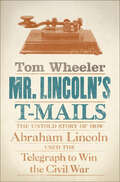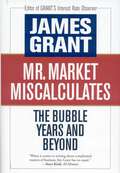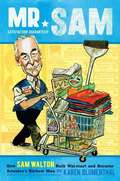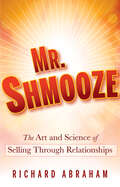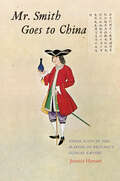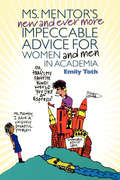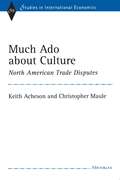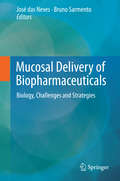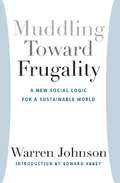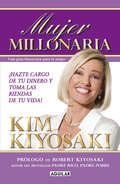- Table View
- List View
Mr. Lincoln's T-Mails: The Untold Story of How Abraham Lincoln Used the Telegraph to Win the Civil War
by Tom WheelerThis “intriguing” look at the sixteenth president’s telegraph usage during the Civil War “revisits a familiar hero, but does so from an utterly new perspective” (Ken Burns).The Civil War was the first “modern war.” Because of rapid changes in American society, Abraham Lincoln became president of a divided United States during a period of technological and social revolution. Among the many modern marvels that gave the North an advantage was the telegraph, which Lincoln used to stay connected to the forces in the field in almost real time.No leader in history had ever possessed such a powerful tool to gain control over a fractious situation. An eager student of technology, Lincoln (the only president to hold a patent) had to learn to use the power of electronic messages. Without precedent to guide him, Lincoln began by reading the telegraph traffic among his generals. Then he used the telegraph to supplement his preferred form of communication—meetings and letters. He did not replace those face-to-face interactions. Through this experience, Lincoln crafted the best way to guide, reprimand, praise, reward, and encourage his commanders in the field.Written by a former FCC chairman, Mr. Lincoln’s T-Mails tells a big story within a small compass—both an elegant work of history and a timeless lesson in leadership. By paying close attention to Lincoln’s “lightning messages,” we see a great leader adapt to a new medium. No reader of this work of history will be able to miss the contemporary parallels. Watching Lincoln carefully word his messages—and follow up on those words with the right actions—offers a striking example for those who spend their days tapping out notes on their various devices.“Mr. Lincoln’s T-Mails shines. . . . an accessible jaunt through this formative American event.” —USA Today“Wheeler shows a Lincoln groping for a best-use of new technology and learning the limitations of the ‘killer app.’”—Booklist“Altogether captivating.” —Harold Holzer, author of Brought Forth on This Continent: Abraham Lincoln and American Immigration
Mr. Market Miscalculates: The Bubble Years and Beyond
by James GrantWhy is America in financial crisis today? This book, better than any to date, explains it all-how we got here and where we are going. The how we got here is brilliantly described in a collection of pieces from Grant's Interest Rate Observer, the Wall Street insider's Bible. The where we are going is treated in Jim Grant's up-to-the-minute introduction. No fan of Greenspan or Bernanke, Grant tells the unvarnished truth about America.
Mr. New York: Lew Rudin and His Love for the City (Excelsior Editions)
by Seymour P. LachmanLew Rudin was one of New York City's most influential power brokers in the latter part of the twentieth century, but he was also one of its most indefatigable boosters. Born in the Throgs Neck section of the Bronx on April 4, 1927, Rudin rose to become cochairman, with his brother, Jack, of one of New York's oldest real estate dynasties, Rudin Management. It is for his civic involvement, however, that he is best remembered. Whether helping to get the New York City Marathon off the ground, or rallying corporate and labor leaders to come to the city's aid during the fiscal crises of the 1970s, Rudin worked tirelessly on behalf of the city he loved. The Association for a Better New York, which he founded in 1971 in response to growing concerns about the city's decline, continues to play a vital role in virtually every area of municipal life, from transportation to education.In Mr. New York, Seymour P. Lachman chronicles Rudin's life and interesting times, and his love affair with the city he never ceased to believe in. Drawing on published materials as well as personal interviews with family members, business associates, and federal, state, and city officials, Lachman paints a portrait of a man who, by the time of his death in 2001, had truly earned the nickname "Mr. New York."
Mr. Sam
by Karen BlumenthalSam Walton grew up to become the founder of Wal-Mart, but he was born with practically nothing except a compulsive drive to win - at football, at becoming class president, at beating everyone no matter what the game. His eventual empire started as nothing more than a dingy one-room general store. He created Wal-Mart - and his massive wealth - one building at a time, one town at a time. This is not a history of his company, but the biography of an uncomplicated man who just wanted to beat the guy down the street. More than forty black-and-white photos illustrate the text. .
Mr. Selfridge in Chicago: Marshall Fields in the Windy City & the Making of a Merchant Price
by Gayle SoucekThis biography recounts the rise of the American retail magnate who would go on to open London&’s famous Selfridge&’s department stores. In early 1909, a new retail emporium readied for business on the &“wrong end of Oxford Street&” in London. The man behind it was an odd little American with a waxed mustache and frenetic nature. Harry Gordon Selfridge had spent the previous twenty-five years in Chicago honing his skills at the venerable Marshall Field and Company before unleashing his concept of retail theater in the United Kingdom. In Mr. Selfridge in Chicago, biographer Gayle Soucek follows the young man&’s astounding rise through the ranks of the Windy City's merchant princes. From working as Mr. Field&’s stock boy to his failed attempt to best his former boss as master of Chicago retail, Soucek follows Selfridge on his tumultuous journey—one that ultimately proves triumphant as he brings the American department store to the United Kingdom.
Mr. Shmooze
by Richard AbrahamReorient your selling approachMr. Shmooze is the parable of a man who reveals the secret shared by all superstar salespeople. Selling, in its most exquisite form, is not about "taking," nor is it about "persuading." Selling, believe it or not, is about "giving." Mr. Shmooze gives for a living. He starts by listening and he quickly comes to understand what people really need. His customers love him because he gives more than he takes. They trust him because he is passionate about their interests. And, at the end of the day, they reward him handsomely for bringing joy, humor and wisdom into their lives. Woven into the story are several powerful lessons for salespeople in all industries who attempt to build relationships as the emotional bridge to their clients.* Bring extraordinary passion and energy to personal communications * Generate contagious, positive feelings, lifting spirits because people buy with their emotions* Make the small, positive gestures that can lead to huge, long-term results * Abraham has had a diverse business career that has established him as a well-known expert on what makes high-performing salespeopleMr. Shmooze gives you the new approach you need to sell like you've never sold before!
Mr. Smith Goes to China: Three Scots in the Making of Britain's Global Empire
by Jessica HanserAn account of eighteenth-century global commerce as seen through the lives of three Scottish traders, “written with verve and filled with arresting details” (Tonio Andrade, author of The Gunpowder Age).This book delves into the lives of three Scottish private traders—George Smith of Bombay, George Smith of Canton, and George Smith of Madras—and uses them as lenses through which to explore the inner workings of Britain’s imperial expansion and global network of trade, revealing how an unstable credit system and a financial crisis ultimately led to greater British intervention in India and China.“This book is a history of British seafaring and imperialism, written largely from a micro-level perspective, placing the focus on individual traders rather than the East India Company as a whole. But it is not only an imperial history. It also unravels the interwoven financial, political and social relations between Britain, China and India in the eighteenth century . . . Hanser has consulted an impressively wide range of archival sources in different languages and located in various countries, from private letters to periodicals, and from official Chinese documents to East India Company reports. Her work contributes to our understanding of 18th-century British imperial history.” —Reviews in History
Mrs. Fields Cookies
by Keri Ostrofsky James I. Cash Jr.Mrs. Fields Cookies is a small company selling freshly baked goods through privately owned specialty stores (each store sells only Mrs. Fields products). The company has about 8,000 employees worldwide and less than 150 information systems people for a unique leverage of MIS resources. The company uses information systems extensively in its processing, communications, and other management functions, including operations of the stores and hiring sales employees. Teaching objectives include discussion of information technology architecture, organizations, management control, and strategy.
Mrs. Fields, Inc.--1977-87
by Lynda M. Applegate Keri PearlsonDescribes a small company selling freshly baked goods through privately owned specialty stores (each store sells only Mrs. Fields products). The company has about 8,000 employees worldwide and less than 150 information systems people for a unique leverage of MIS resources. The company uses information systems extensively in its processing, communications, and other management functions, including operations of the stores and hiring sales employees. Teaching objectives include discussion of information technology architecture, organizations, management control, and strategy. A condensed version of Mrs. Fields Cookies.
Ms. Mentor's New and Ever More Impeccable Advice for Women and Men in Academia
by Emily Toth"The divine Ms. M. is back, with realistic and witty advice about life in academia. Required reading."-Elaine Showalter, Princeton University. "At last, Ms. Mentor Unplugged, Uncensored, and Unrepentant! This is a great and clear-headed read for junior academics trying to find their way to success through the thicket of professional obfuscation and a good reminder to senior people about just how confusing academe is to the uninitiated."-Cathy Davidson, Duke University. "Part Emily Post, part Dame Edna, Ms. Mentor continues to dispense wicked truths in her trademark style. Tucking her professional advice into very funny and frequently appalling stories (I believe every one), she sends encouraging word from the only ivory tower left standing."-William Germano, The Cooper Union. Ms. Mentor, that uniquely brilliant and irascible intellectual, is your all-knowing guide through the jungle that is academia today. In the last decade Ms. Mentor's mailbox has been filled to overflowing with thousands of plaintive epistles, rants, and gossipy screeds. A mere fraction has appeared in her celebrated monthly online and print Q&A columns for the Chronicle of Higher Education; her readers' colorful and rebellious ripostes have gone unpublished-until now. Hearing the call for a follow-up to the wildly successful Ms. Mentor's Impeccable Advice for Women in Academia, Ms. Mentor now broadens her counsel to include academics of the male variety. Ms. Mentor knows all about foraging for jobs, about graduate school stars and serfs, and about mentors and underminers, backbiters and whiners. She answers burning questions: Am I too old, too working class, too perfect, too blonde? When should I reproduce? When do I speak up, laugh, and spill the secrets I've gathered? Do I really have to erase my own blackboard? Does academic sex have to be reptilian? From the ivory tower that affords her an unparalleled view of the academic landscape, Ms. Mentor dispenses her perfect wisdom to the huddled masses of professorial newbies, hardbitten oldies, and anxious midcareerists. She gives etiquette lessons to academic couples and the tough-talking low-down on adjunct positions. She tells you what to wear, how to make yourself popular, and how to decode academic language. She introduces you to characters you must know: Professor Pelvic, Dr. Iron Fist, Mr. Upstart Whelp, Dean Titan, Professor McShameless. In this volume Ms. Mentor once again shares her wide-ranging unexpurgated wisdom, giving tips on bizarre writing rituals, tenure diaries, and time management (Exploding Head Syndrome). She decodes department meetings and teaches you the tricks for getting stellar teaching evaluations. Raw, shocking, precise, clever, absurd--Ms. Mentor has it all.
Mt. Auburn Hospital
by F. Warren Mcfarlan Jaan EliasIn December of 1993, two of Boston's largest and best known hospitals, Massachusetts General and Brigham and Women's, announced that they were setting aside their historic rivalry to form an alliance and build a regional health network. The announcement set off a wave of merger talk throughout a Boston health care market that was carrying too many specialists, beds, and service providers. Like its peers, Mt. Auburn Hospital began a search for an alliance. The hospital had managed to thrive during the previous decade by restructuring its operations in response to the revolution in managed care. But in a health care environment potentially dominated by regional networks, the hospital's position as a mixture of community and teaching hospital had made it vulnerable. Mt. Auburn's board of trustees formed a special task force on alliances to solicit proposals and make a recommendation as to which (if any) organization would make for the best partner. The suitors that showed up at the task force's door represented nearly every type of player in the health care market. In February of 1996, the task force faced the daunting task of picking through the various alternatives.
Mt. Auburn Partners Search Fund
by William A. Sahlman Dan HeathProvides background on search funds and follows two partners as they try to raise financing for a search fund.
Mu oz Group: Sustaining Global Vertical Integration Through Innovation
by Annelena Lobb Jose B. AlvarezMu oz Group, which supplied supermarket chains and food distribution chains around the world with fruit, flowers, juice and ice cream, was at a strategic crossroads in 2014. CEO Alvaro Mu oz had to choose the best way to achieve profit goals and provide his company with a sustainable competitive advantage. The company had already developed innovative citrus, grape and flower breeding units in efforts to keep its product pipeline on the cutting edge. The company also worked to integrate vertically-to own or control every viable piece of the supply chain-in an effort to manage the flower and produce businesses from plant to retailer. The company's stronghold was its UK and European markets, but it had expanded into North America and also eyed new opportunities in Asia. Mu oz had to decide where to focus his efforts against a backdrop of margin squeezes in the food business, competition for product from the developing world, ever more stringent quality, sustainability, and environmental standards from clients, and perennial hiring challenges.
MuMate
by Thomas R. Eisenmann Alex GoddenMuMate, a fictional cult beverage company, requires capital to fund national expansion. Its cofounders, who have bootstrapped to this point, are now negotiating with venture capital firms to raise a $3 million funding round. The case describes MuMat 's inception, early history, business model, and factors that have fueled its rapid recent growth. As the case ends, the cofounders are debating whether to raise funds from VCs, angels, or asset-based lenders. The cofounders share their concerns about valuation and whether investors will seek to change the company's strategy and organizational culture.
MuMate B-1: Confidential for Maxwell
by Thomas R. Eisenmann Alex GoddenMuMate, a fictional cult beverage company, requires capital to fund national expansion. Its cofounders, who have bootstrapped to this point, are now negotiating with venture capital firms to raise a $3 million funding round. The case describes MuMate's inception, early history, business model, and factors that have fueled its rapid recent growth. As the case ends, the cofounders are debating whether to raise funds from VCs, angels, or asset-based lenders. The cofounders share their concerns about valuation and whether investors will seek to change the company's strategy and organizational culture.
MuMate B-2: Confidential for Cantor
by Thomas R. Eisenmann Alex GoddenMuMate, a fictional cult beverage company, requires capital to fund national expansion. Its cofounders, who have bootstrapped to this point, are now negotiating with venture capital firms to raise a $3 million funding round. The case describes MuMate's inception, early history, business model, and factors that have fueled its rapid recent growth. As the case ends, the cofounders are debating whether to raise funds from VCs, angels, or asset-based lenders. The cofounders share their concerns about valuation and whether investors will seek to change the company's strategy and organizational culture.
Much Ado About Culture: North American Trade Disputes
by Keith Acheson Christopher MauleIn Canada, the audio-visual and print industries are referred to as the cultural industries, whereas the United States calls them the entertainment industries. These language distinctions are accompanied by different domestic policies and political discourses. The United States has relatively open policies toward these activities, while Canada has adopted an inward-looking approach. Failure to integrate cultural industries into NAFTA and WTO has led to trade disputes between Canada and the United States over copyrights, television licensing, violence in media, and discriminatory magazine policy, indicating the need for an agreed-upon process for settling cultural trade disputes. Much Ado about Cultureexplores the differing sets of policies--cultural nationalism versus the open option--and the resulting conflicts in the context of technological developments as well as international agreements dealing with trade, investment, copyright, and labor movements. The Canadian cultural industries are examined, from film and television production and distribution to broadcasting, publishing, and sound recording. Several areas of recent conflict, such asSports Illustrated, Country Music Television, and Borders Books, highlight the types of policies disputed, the process followed, and the conclusions reached. Finally, the authors propose an alternative approach to constraining national cultural policies by international agreement that would allow the gains from openness to be realized while serving legitimate cultural concerns. Authored by the acknowledged experts on trade disputes in the cultural arena, this book will be essential reading for international economists, policymakers, and lawyers interested in the cultural industries. Keith Acheson and Christopher Maule are Professors of Economics, Carleton University, Ontario.
Much Ado About Nothing? Estimating the Impact of a U.S. Slowdown on Thai Growth
by Ivan Tchakarov Shekhar AiyarA report from the International Monetary Fund.
Much More Than a Game
by Robert F. BurkTo most Americans, baseball is just a sport; but to those who own baseball teams--and those who play on them--our national pastime is much more than a game. In this book, Robert Burk traces the turbulent labor history of American baseball since 1921. His comprehensive, readable account details the many battles between owners and players that irrevocably altered the business of baseball. During what Burk calls baseball's "paternalistic era," from 1921 to the early 1960s, the sport's management rigidly maintained a system of racial segregation, established a network of southern-based farm teams that served as a captive source of cheap replacement labor, and crushed any attempts by players to create collective bargaining institutions. In the 1960s, however, the paternal order crumbled, eroded in part by the civil rights movement and the competition of television. As a consequence, in the "inflationary era" that followed, both players and umpires established effective unions that successfully pressed for higher pay, pensions, and greater occupational mobility--and then fought increasingly bitter struggles to hold on to these hard-won gains.
Mucosal Delivery of Biopharmaceuticals
by Bruno Sarmento José Das NevesBiopharmaceutical medicines, the newest class of therapeutics, are quite heterogeneous and include a range of molecules such as proteins, peptides, vaccines and nucleic acids, with use in virtually all therapeutic fields (e. g. cancer and infectious diseases, vaccination, metabolic dysfunctions) and diagnostics. This edited book gives a concise and up-to-date overview of the biological features justifying the use of different human mucosa as delivery routes for biopharmaceuticals, the technological strategies that have been followed so far regarding the optimization of mucosal potentialities as well as the challenges that arise with the advent of new biopharmaceutical drugs and alternative means of administration. Following a brief introduction, the first section addresses general aspects of the biology of mucosal tissues and their unique aspects toward beneficial or deleterious interaction with biopharmaceuticals and their delivery systems. The second part reviews the different delivery strategies that have recently been investigated for different mucosal sites. The third section describes the development and clinical applications of drug delivery systems and products enclosing biopharmaceuticals for mucosal delivery, with a focus on the most successful case studies of recent years. The last section briefly centers on relevant aspects of the regulatory, toxicological and market issues of mucosal delivery of biopharmaceuticals. Scientists and researchers in the fields of drug delivery, material science, biomedical science and bioengineering as well as professionals, regulators and policy makers in the pharmaceutical, biotechnology and healthcare industries will find in this book an important compendium of fundamental concepts and practical tools for their daily research and activities.
Muddling Toward Frugality
by Warren JohnsonMr. Johnson's thesis can be summarized without much difficulty: after generations of extravagant and reckless industrial expansion, we are clearly entering an age of economic scarcity. While human demands continue to rise, natural resources, especially the non-renewable kind, become harder to find and more expensive to extract, process, transport and distribute. This simple brute fact is the basic cause of inflation, despite the inability of most professional economists to see it. (The "dismal science" has never been more dismally obtuse than it is today.) The law of diminishing returns is coming into effect. Technological developments can delay the process but not halt or reverse it; nor can we rely on government or big business to save us. Planning for further growth delays the adjustments that must be made, makes a fair sharing of necessary sacrifices more troublesome, and if carried too far will make more severe and painful, because rapid, the inevitable decline of the international economic machine. The best way to deal with the end of affluence is to accept it-not fight it-and to begin, here and now, the unavoidable adaptations, on an individual, family, and community basis. Piecemeal, experimental, and muddling.
Muddy Waters vs. eHealth: The Debate of a "Lifetime"
by Jonas Heese Cristo LiautaudIn May 2020, an analyst was assessing eHealth's performance. eHealth was an online / tele-sales broker of health insurance products. The stock had recently hit all-time highs, closing at a peak of $146 on March 4, 2020. But now, May 4, 2020, eHealth traded at $103. The recent fall had wiped nearly $1.0B from the company's market capitalization because well-known short seller Carson Block had released a short-report on the company. Carson Block argued that eHealth's management had undertaken "massive stock promotion." In the report, Block said that eHealth's adoption of the new revenue recognition standard - ASC 606 - inflated revenue and masked the fact that eHealth was losing money on each new policy that it sold. Still, eHealth's valuation remained elevated at 3.3x FY2021E Revenue, 21x FY2021E adjusted net income, even assuming away accounting uncertainty. In addition, the mean consensus share price target as of May 4, 2020 was $179. Did the latest news provide a buying opportunity? Or was it best to avoid eHealth, even perhaps consider shorting the company?
Mueller-Lehmkuhl GmbH
by Robin Cooper Dagmar BottenbruchMueller-Lehmkuhl sells apparel fasteners and rents attaching machines. It views these two products as effectively a single item and prices them accordingly, the fasteners at high profit and its attaching machines at a loss. The cost system allocates the cost of the attaching machines to the fasteners. The Japanese have entered the market and found a way to unbundle the two products. As a result they are challenging the European way of doing business. The case asks the student to analyze the true cost and profitability of the products.
Mujer millonaria
by Kim Kiyosaki¡Hazte cargo de tu dinero y toma las riendas de tu vida! Este libro es para ti si no quieres volver a perder el sueño a causa del dinero; quieres tener el control de tu futuro económico; estás cansada de buscar un príncipe azul millonario; exiges independencia verdadera. Este libro es para toda mujer que se empeñe en ser económicamente independiente.
Mujeres Innovadoras
by Justin Sachs Alma Edith GarciaMujeres Innovadoras presenta a las principales emprendedoras y sus secretos del oficio. Va detrás de las cámaras dentro de las empresas dirigidas por mujeres y comparte los principios rectores, las herramientas y las estrategias que les ayudan para competir. Si usted está buscando iniciar un negocio o está buscando construir uno que ya ha iniciado, estas mujeres compartirán sus mejores consejos de cómo se puede tener éxito. El libro describe los pasos específicos que las mujeres pueden tomar para combinar el éxito empresarial con la realización personal e ilustra los beneficios de las mujeres en el ámbito laboral y en el hogar.
